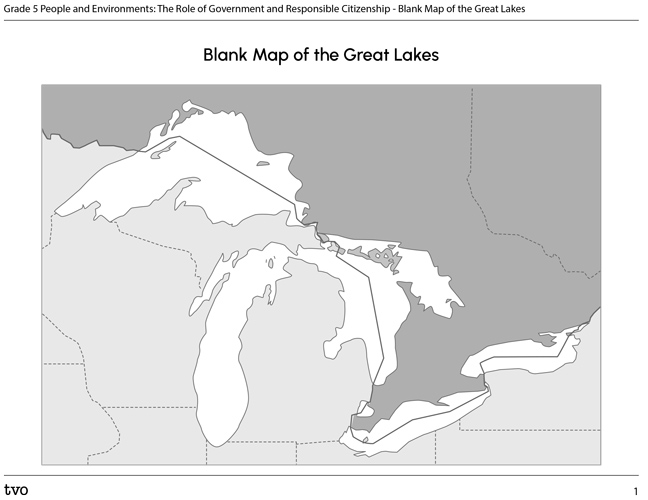Minds On
The Great Lakes
Explore the following map of the Great Lakes.
 Description
Description
There are five Great Lakes: Lake Superior, Lake Huron, Lake Erie, Lake Ontario, and Lake Michigan. Lake Michigan is the only lake completely in the United States. On the map there is a line through four of the lakes (Superior, Huron, Erie, and Ontario). This is the border between Canada and the United States. The Great Lakes are located in Ontario.
Brainstorm
Why are the Great Lakes important?
Answer the following questions:
- What are some things your notice and wonder about the Great Lakes?
- Why do you think the Great Lakes are important?
- How do the Great Lakes meet the needs of human and animal life?
Record your ideas on paper, on the computer, in an audio recording, or using another method of your choice.
Action
The importance of the Great Lakes

The Great Lakes are essential for many reasons. Let’s examine the following list of reasons why the Great Lakes are important to Canada and its citizens.
- provides Canadians with electricity and helps to moderate the climate
- important to North America’s economy
- contributes to the province of Ontario’s tourism sector
- helps promote different recreational opportunities
- provides drinkable water (largest bodies of freshwater on earth)
- provides Canadians with fish
- significance and importance to Indigenous communities
- natural beauty and diverse ecosystems
While all these are important, are there some items on that list that felt more important to you than others?
In this activity, use your personal judgement to rank the reasons why the Great Lakes are important, from what you believe to be the most important to least important. Then, reflect on why your ordered them the way you did and if you struggled to rank them easily.
Record your ideas on paper, on the computer, in an audio recording, or using another method of your choice.
The importance of water to Indigenous communities
Many Indigenous communities recognize, honour, and respect water as a sacred gift that is important for all life. The Great Lakes are important for fishing, hunting, farming, trading, and harvesting. First Nations communities who live within the Great Lakes Basin share an important relationship with the lakes and identify a shared responsibility to protect the waters. They have practiced this responsibility since time immemorial, or as long as can be remembered.
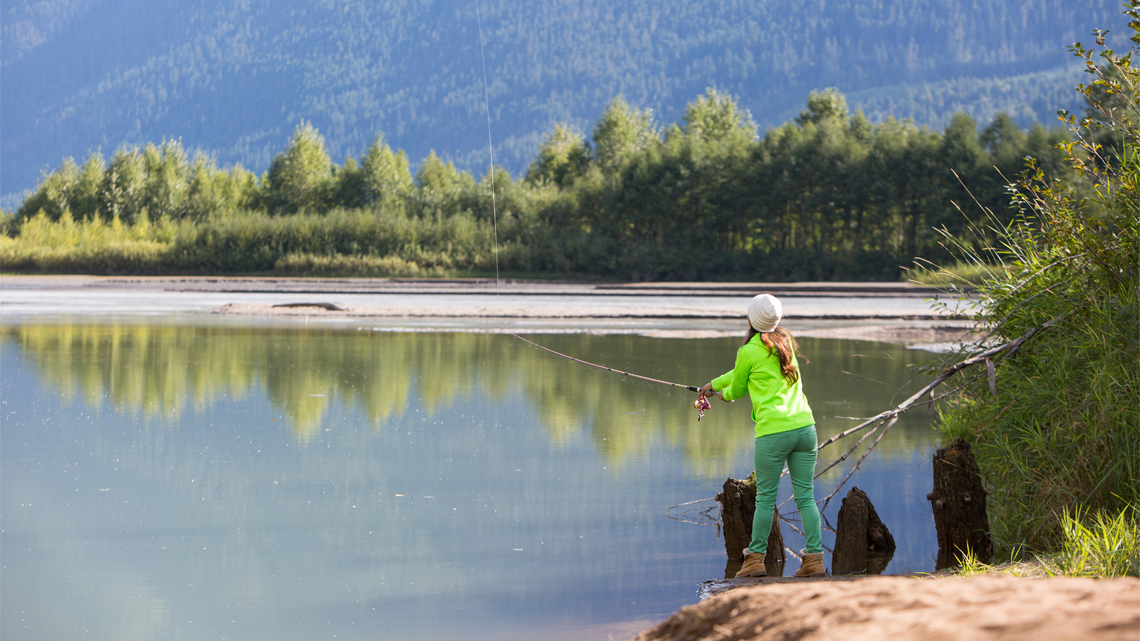
Over time, settler pressures on the land increased, and with it, so did pollution and destruction of the environment. This is the reason why many Indigenous communities today cannot also harvest, hunt, fish, or trap in their traditional way or drink the water from the Great Lakes.
In Ontario, the Annual Mother Earth Water Walk raises awareness about the importance of water, including the health of the Great Lakes. It evolved through the efforts of two Anishinaabe grandmothers who walked the perimeters of the Great Lakes to draw attention to the issues impacting the waters.
Current challenges in the Great Lakes
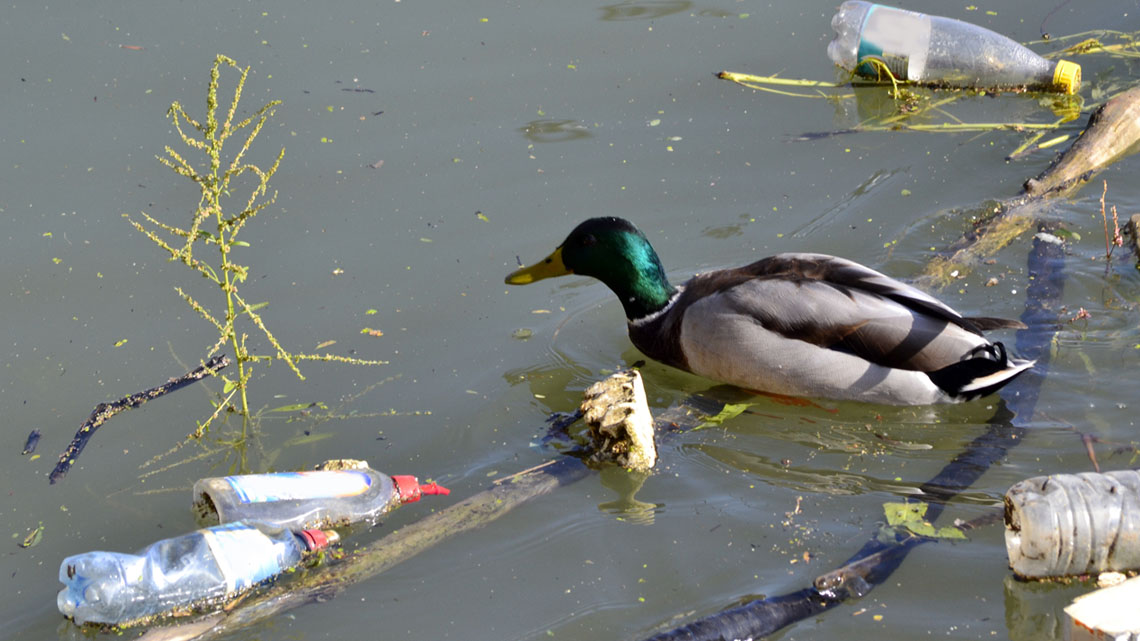
Explore the current concerns effecting the Great Lakes. As you explore them, reflect on what can be done to support the Great Lakes.
Press on each of the following concerns to learn more about what is currently affecting Canada’s Great Lakes.
Increased population can put stress on the ecosystem and cause loss of habitats (wetlands).

Untreated sewage can add unwanted phosphorus and contaminants.
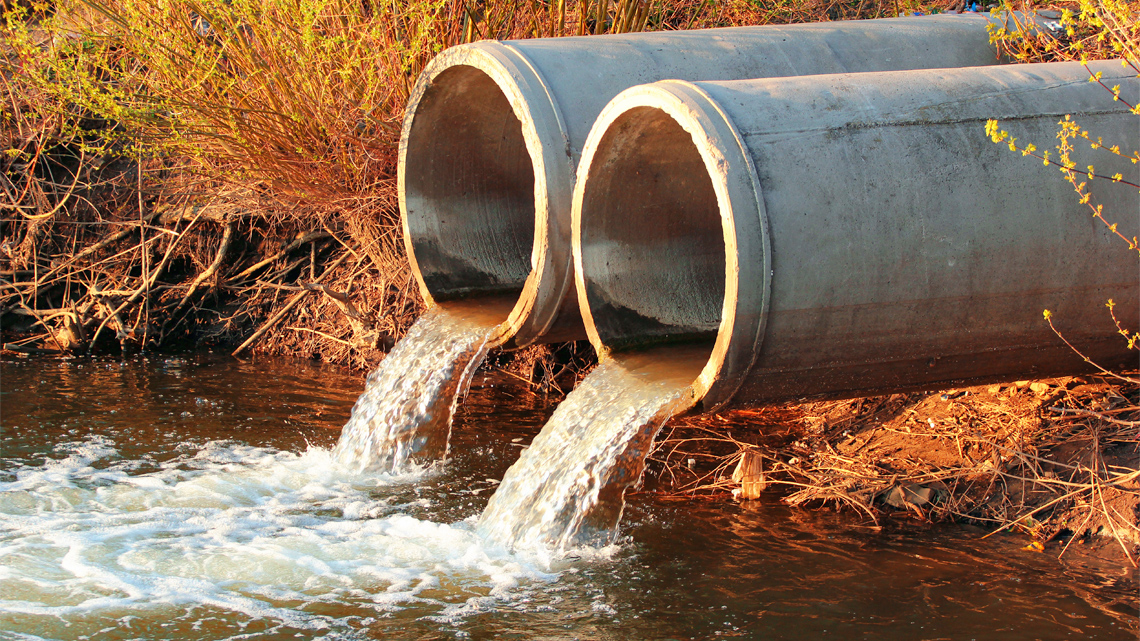
Invasive species can affect the ecosystem. Some types of invasive species are:
- plants have taken over some shoreline areas
- Asian carp, which are problematic for ecosystems and fisheries
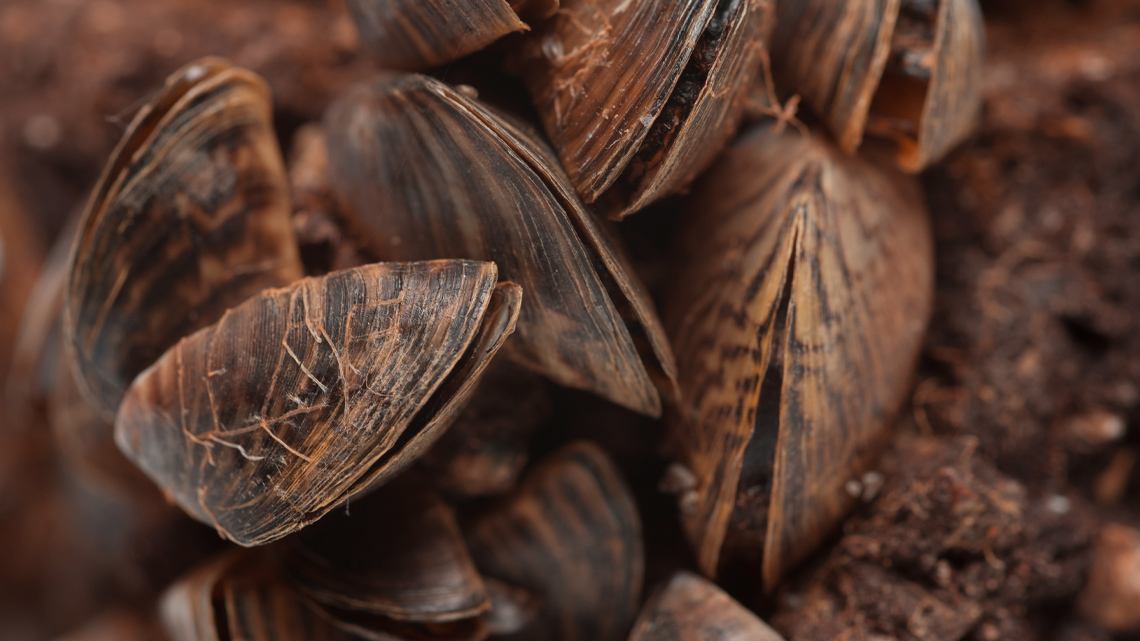
Climate change, caused by pollution, can cause changing water levels and high summer temperatures.
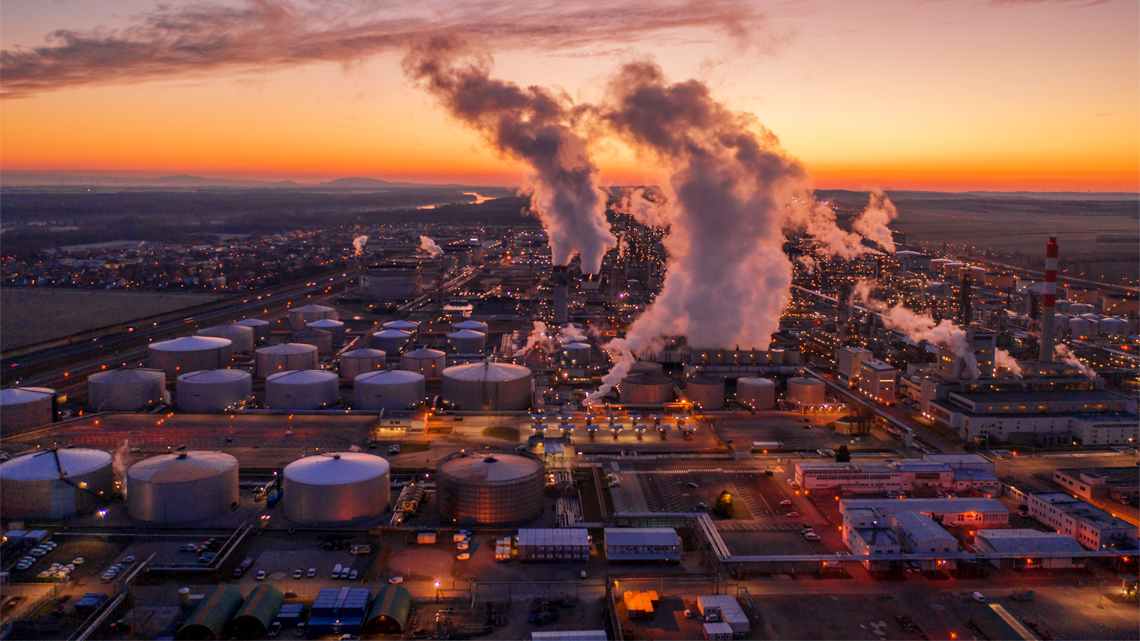
These are newer chemicals, such as some flame retardants and pharmaceuticals. They come from urban, industrial, and agricultural sources.

More algae is growing in Great Lakes waters. Some shorelines are covered by slimy masses of algae, some of which is toxic.
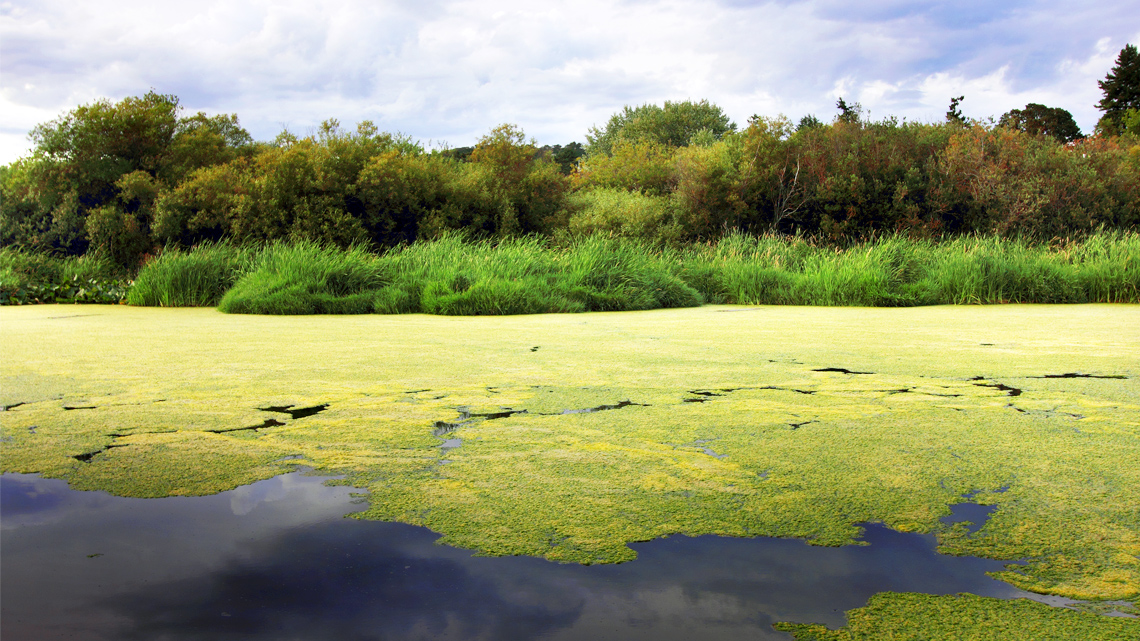
Using maps to help identify levels of government
Now that we have explored why the Great Lakes are important to Canada and its people and considered what the current concerns affecting them are, we need to ask a new question.
Who’s responsible for addressing these issues?
What levels of government do you believe are responsible for addressing these issues? Why?
Student Tips
Student tips
Does the following map provide any clues to what levels of government might be involved?
 Description
Description
There are five Great Lakes: Lake Superior, Lake Huron, Lake Erie, Lake Ontario, are in Ontario. Only Lake Michigan is in the United States. On the map there is a line through four of the lakes (Superior, Huron, Erie, and Ontario). This is the border between Canada and the United States. There are also various towns on Lake Superior and Georgian Bay. For example, Perry Sounds, Sault Ste Marie, and Thunder Bay.
Brainstorm
What needs to be included on the map?
What information would you need to include on a map to show how and why the issue of pollution in the Great Lakes involves several different governments?
Record your ideas using a method of your choice.
Use the map provided or a digital mapping tool of your choice to create your map.
Press ‘Hint’ to reveal some suggested answers to the previous questions.
- The Provincial and Federal governments are responsible for addressing the issues and they are responsible for engaging Indigenous governments such as the Métis Nation of Ontario, First Nations communities (both hereditary and band council systems), treaty partners, and rights holders in the Great Lakes regions.
- The Great Lakes are in Ontario; this means the Ontario Provincial government is responsible. The lakes are also divided by a border; this means that the Federal government is also responsible. The Federal government must communicate with the United States to develop a plan of action. The Federal government also assists the Provincial government with their plan of action. The Indigenous governments surrounding the Great Lakes use their extensive knowledge of the regions to contribute to the well-being of the lakes.
- The map could include: features to identify where pollution is coming from, an area of concern (in Canada or the USA), areas where restoration projects are occurring, treaty land agreements, etc.
How are the Provincial and Federal government taking action?
Both the Provincial and Federal government have taken action to help address the concerns affecting the Great Lakes.
Press Provincial to explore Ontario’s plan for restoring the Great Lakes.
|
1) Engaging and empowering communities |
Great Lakes Guardian Community Fund Provides funding for community groups, non-profit organizations, and First Nations and Métis communities as they seek to restore the Great Lakes |
|---|---|
|
2) Protecting water for human and ecological health |
Protects the quality and quantity of the water and reduce toxic chemicals |
|
3) Improving wetlands, beaches, and coastal areas |
Works with various organizations, monitoring water quality, improving wetland mapping, enhancing protection of coastal wetlands/shoreline areas, and prohibiting development in some areas |
|
4) Protecting habitats and species |
Created an invasive species hotline, establishes protected areas, collaborates with the Federal Government, provides tax incentives, increases public awareness for biodiversity, and detects and manages invasive species |
|
5) Enhancing understanding and adaptation |
Improves existing methods to monitor climate change, supports Great Lakes research, and continues to develop new technologies to enhance sampling |
|
6) Ensuring environmentally sustainable economic opportunities and innovation |
Encourages the use of green technologies, promotes tourism, encourages public access to waterfront areas and sustainable use of water-based recreation |
Information synthesized from https://www.ontario.ca/page/ontarios-great-lakes-strategy#section-7
Press Federal to learn how the Federal Government is assisting with restoring the Great Lakes.
|
Developed two agreements |
1) The 2012 Canada-US Great Lakes Water Quality Agreement Focuses on:
|
|---|---|
|
2) Canada-Ontario Agreement on Great Lakes Water Quality and Ecosystem Health Focuses on:
|
|
|
Provides funds for Great Lakes Protection Initiatives |
Fund actions to:
|
Source: Canada, Environment and Climate Change. “Government of Canada.” Canada.ca, / Gouvernement Du Canada, 5 July 2019, www.canada.ca/en/environment-climate-change/services/great-lakes-protection/agreements.html.
Matching activity
For each issue affecting the Great Lakes, select the corresponding action that is being taken to help address the issue or identify which level of government is helping solve the issue.
Consolidation
Indigenous contributions

As the provincial and federal governments work towards taking action, Indigenous communities are also finding ways to uphold their traditional roles and responsibilities to the waters.
Select one of the concerns affecting the Great Lakes and explore how Indigenous communities are taking action. Identify various Indigenous communities' initiatives around the Great Lakes.
You may record your thoughts using the chart provided, a journal, an audio recording, on the computer, or another method your choice. Respond to the following prompts:
- State and give a brief description of the problem.
- Who/what is impacted by this issue/concern?
- What steps have already been taken to solve the problem?
- Have any other problems arisen because the problem is still an issue?
- Have the current efforts been effective? Why or why not?
Complete the following fillable and printable mind map Great Lake Concerns. You can also complete this activity in your notebook or using a method of your choice.
|
Describe the problem |
|
|---|---|
|
Who/what is impacted by this issue? |
|
|
What steps have already been taken to solve the problem? |
|
|
Have any other problems arisen because the problem is still an issue? |
|
|
Have the current efforts been effective? Why or why not? |
Press the ‘Activity’ button to access Great Lake Concerns.
Reflection
As you read through these descriptions, which sentence best describes how you are feeling about your understanding of this learning activity? Press the button that is beside this sentence.
I feel...
Now, record your ideas using a voice recorder, speech-to-text, or writing tool.
Press ‘Discover More’ to extend your skills.
Discover More
Inform the Provincial or Federal government about the effectiveness of their actions in addressing issues related to the Great Lakes.
Some suggestions include:
- compose a letter (include: date, salutation, body (add your details and opinions, give evidence to support reasonings), closing or signature)
- create a poster
- create a commercial/a short film or video
- any other method that interests you.
Give your opinions and use the information or data you collected as evidence to support your ideas.
